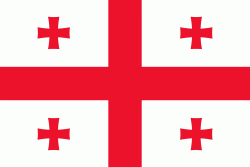Tsinandali (Ts’inandali)
Tsinandali (წინანდალი) is a village in Kakheti, Georgia, situated in the district of Telavi, 79 km east of Tbilisi. It is noted for the palace and historic winery-estate which once belonged to the 19th-century aristocratic poet Alexander Chavchavadze (1786–1846) and which, since 2019, is the venue for the Tsinandali Festival.
Alexander Chavchavadze inherited this village, lying in the Alazani River valley, from his father, Prince Garsevan. He refurbished the estate, constructed a new Italianate palace and built a decorative garden. As scientists claim by 1812 Tsinandali garden had two palaces, one built by Garsevan and another by his son Alexander Chavchavadze. It was the place where prince Alexander Chavchavadze frequently entertained foreign guests with music, wit, and – most especially – the fine vintages made at his estate marani (winery). Familiar with European ways, Chavchavadze built Georgia's oldest and largest winery where he combined European and centuries-long Georgian winemaking traditions. The highly regarded dry white Tsinandali is still produced there.
The village and the Chavchavadze estate were further famed by a surprising raid by the troops of Imam Shamil, a Muslim leader of the North Caucasian opposition to the Russian expansion, on July 2, 1854. The attack was commanded by Ghazi-Muhammad, Shamil's son. Avenging the Chavchavadze family for their contribution to the Russian success in the Caucasian War, the mountaineers pillaged the estate and kidnapped the wife of Alexander's son, Prince David Chavchavadze, her widowed sister, Varvara Orbeliani, who were both granddaughters of George XII of Georgia, their children and several relatives. This event sent waves of shock not only into Russia, but the West as well. On March 22, 1855, after complicated negotiations, the hostages were exchanged for Shamil's captive son Jamal al-Din and 40,000 silver rubles as part of a deal involving a general exchange of prisoners.
After David Chavchavadze's death, due to the failure to pay the debt to the Russian Public Bank, the estate passed to the property of the Imperial family. The Tsinandali garden was renovated in 1887 and passed to the state in 1917. In 1947, the estate was organized into a museum. In 2007, a major renovation of the palace and redevelopment of the park was proposed in conjunction with the Smithsonian Institution, and undertaken by the Silk Road Group whose founder is also a force behind the international music festival at the site.
Alexander Chavchavadze inherited this village, lying in the Alazani River valley, from his father, Prince Garsevan. He refurbished the estate, constructed a new Italianate palace and built a decorative garden. As scientists claim by 1812 Tsinandali garden had two palaces, one built by Garsevan and another by his son Alexander Chavchavadze. It was the place where prince Alexander Chavchavadze frequently entertained foreign guests with music, wit, and – most especially – the fine vintages made at his estate marani (winery). Familiar with European ways, Chavchavadze built Georgia's oldest and largest winery where he combined European and centuries-long Georgian winemaking traditions. The highly regarded dry white Tsinandali is still produced there.
The village and the Chavchavadze estate were further famed by a surprising raid by the troops of Imam Shamil, a Muslim leader of the North Caucasian opposition to the Russian expansion, on July 2, 1854. The attack was commanded by Ghazi-Muhammad, Shamil's son. Avenging the Chavchavadze family for their contribution to the Russian success in the Caucasian War, the mountaineers pillaged the estate and kidnapped the wife of Alexander's son, Prince David Chavchavadze, her widowed sister, Varvara Orbeliani, who were both granddaughters of George XII of Georgia, their children and several relatives. This event sent waves of shock not only into Russia, but the West as well. On March 22, 1855, after complicated negotiations, the hostages were exchanged for Shamil's captive son Jamal al-Din and 40,000 silver rubles as part of a deal involving a general exchange of prisoners.
After David Chavchavadze's death, due to the failure to pay the debt to the Russian Public Bank, the estate passed to the property of the Imperial family. The Tsinandali garden was renovated in 1887 and passed to the state in 1917. In 1947, the estate was organized into a museum. In 2007, a major renovation of the palace and redevelopment of the park was proposed in conjunction with the Smithsonian Institution, and undertaken by the Silk Road Group whose founder is also a force behind the international music festival at the site.
Map - Tsinandali (Ts’inandali)
Map
Country - Georgia_(country)
 |
 |
| Flag of Georgia (country) | |
During the classical era, several independent kingdoms became established in what is now Georgia, such as Colchis and Iberia. In the early 4th century, ethnic Georgians officially adopted Christianity, which contributed to the spiritual and political unification of the early Georgian states. In the Middle Ages, the unified Kingdom of Georgia emerged and reached its Golden Age during the reign of King David IV and Queen Tamar in the 12th and early 13th centuries. Thereafter, the kingdom declined and eventually disintegrated under the hegemony of various regional powers, including the Mongols, the Turks, and various dynasties of Persia. In 1783, one of the Georgian kingdoms entered into an alliance with the Russian Empire, which proceeded to annex the territory of modern Georgia in a piecemeal fashion throughout the 19th century.
Currency / Language
| ISO | Currency | Symbol | Significant figures |
|---|---|---|---|
| GEL | Georgian lari | ₾ | 2 |
| ISO | Language |
|---|---|
| HY | Armenian language |
| AZ | Azerbaijani language |
| KA | Georgian language |
| RU | Russian language |















